Influence of Pressure on the Mechanical and Electronic Properties of Wurtzite and Zinc-Blende GaN Crystals
Abstract
:1. Introduction
2. Computational Methods
3. Results and Discussion
3.1. Structural Properties
3.2. Elastic Constants
3.3. Elastic Anisotropy
3.4. Electronic Properties
4. Conclusions
- (1)
- The lattice constants and elastic constants of wurtzite and zinc-blende GaN crystals calculated by both GGA and LDA match well with the experimental values. The structures of the two GaN crystals are stable under the pressure up to 40 GPa.
- (2)
- Bulk moduli increase while shear moduli decrease with the increase in pressure, resulting in the significant increase of the ratios of bulk moduli to shear moduli for the two GaN crystals. The two GaN crystals are brittle materials at zero pressure, while they exhibit ductile behaviours under high stresses.
- (3)
- Increase in pressure raises the elastic anisotropy of GaN single crystals, and the anisotropy factors of the two GaN crystals are quite different. Wurtzite GaN exhibits an isotropic character of elastic modules at the (001) plane, while showing obvious anisotropy at planes (100) and (010). The maximum value is located at the [001] axis. Zinc-blende GaN shows the anisotropic elastic modulus in all planes, and the minimum and maximum values are in the directions <100> and <111>, respectively.
- (4)
- Compared to the obvious directional dependences of elastic moduli at different pressures, the shear modulus has an inverse trend for the two GaN single crystals. There is hardly any anisotropy for bulk modulus, especially for that of zinc-blende GaN.
- (5)
- The two GaN crystals show similar atomic bonding and hybridization behaviour between Ga and N atoms. The band gaps of GaN crystals increase with increasing pressure, and zinc-blende GaN has a larger pressure coefficient.
Author Contributions
Funding
Conflicts of Interest
References
- Nakamura, S. The roles of structural imperfections in InGaN-based blue light-emitting diodes and laser diodes. Science 1998, 281, 956–961. [Google Scholar] [CrossRef]
- Wang, X.; Chang, B.; Ren, L.; Gao, P. Influence of the p-type doping concentration on reflection-mode GaN photocathode. Appl. Phys. Lett. 2011, 98, 082109. [Google Scholar] [CrossRef]
- Chen, J.; Xue, C.; Zhuang, H.; Yang, Z.; Qin, L.; Li, H.; Huang, Y. Catalytic synthesis and optical properties of large-scale GaN nanorods. J. Alloy Compd. 2009, 468, L1–L4. [Google Scholar] [CrossRef]
- Paskova, T.; Hanser, D.A.; Evans, K.R. Gan substrates for III-Nitride devices. Proc. IEEE 2010, 98, 1324–1338. [Google Scholar] [CrossRef]
- Zhuang, D.; Edgar, J. Wet etching of GaN, AlN, and SiC: A review. Mater. Sci. Eng. R Rep. 2005, 48, 1–46. [Google Scholar] [CrossRef]
- Dasari, K.; Wu, J.; Huhtinen, H.; Jadwisienczak, W.M.; Palai, R. Growth, luminescence and magnetic properties of GaN:Er semiconductor thin films grown by molecular beam epitaxy. J. Phys. D: Appl. Phys. 2017, 50, 175104. [Google Scholar] [CrossRef]
- Gao, X.; Man, B.; Zhang, C.; Leng, J.; Xu, Y.; Wang, Q.; Zhang, M.; Meng, Y. The important role of Ga vacancies in the ferromagnetic GaN thin films. J. Alloys Compd. 2017, 699, 596–600. [Google Scholar] [CrossRef]
- Paisley, M.J.; Sitar, Z.; Posthill, J.B.; Davis, R.F. Growth of cubic phase gallium nitride by modified molecular-beam epitaxy. J. Vac. Sci. Technol. A Vac. Surf. Films 1989, 7, 701–705. [Google Scholar] [CrossRef]
- Lei, T.; Fanciulli, M.; Molnar, R.J.; Moustakas, T.D.; Graham, R.J.; Scanlon, J. Epitaxial growth of zinc blende and wurtzitic gallium nitride thin films on (001) silicon. Appl. Phys. Lett. 1991, 59, 944–946. [Google Scholar] [CrossRef]
- Pankove, J.I. Perspective on gallium nitride. MRS Online Proc. Libr. Arch. 1989, 162. [Google Scholar] [CrossRef]
- Zywietz, T.K.; Neugebauer, J.; Scheffler, M. The adsorption of oxygen at GaN surfaces. Appl. Phys. Lett. 1999, 74, 1695–1697. [Google Scholar] [CrossRef]
- Adelmann, C.; Brault, J.; Mula, G.; Daudin, B.; Lymperakis, L.; Neugebauer, J. Gallium adsorption on (0001) GaN surfaces. Phys. Rev. B 2003, 67, 165419. [Google Scholar] [CrossRef]
- Rosa, A.L.; Neugebauer, J.; Northrup, J.E.; Lee, C.D.; Feenstra, R.M. Adsorption and incorporation of silicon at GaN (0001) surfaces. Appl. Phys. Lett. 2002, 80, 2008–2010. [Google Scholar] [CrossRef]
- Lee, D.S.; Lee, J.H.; Lee, Y.H.; Lee, D.D. GaN thin films as gas sensors. Sens. Actuators B Chem. 2003, 89, 305–310. [Google Scholar] [CrossRef]
- Pearton, S.; Zolper, J.; Shul, R.; Ren, F. GaN: Processing, defects, and devices. J. Appl. Phys. 1999, 86, 1–78. [Google Scholar] [CrossRef]
- Reshchikov, M.A.; Demchenko, D.O.; Usikov, A.; Helava, H.; Makarov, Y. Carbon defects as sources of the green and yellow luminescence bands in undoped GaN. Phys. Rev. B 2014, 90, 235203. [Google Scholar] [CrossRef]
- Li, L.; Yu, J.; Hao, Z.; Wang, L.; Wang, J.; Han, Y.; Li, H.; Xiong, B.; Sun, C.; Luo, Y. Influence of point defects on optical properties of GaN-based materials by first principle study. Comp. Mater.Sci. 2017, 129, 49–54. [Google Scholar] [CrossRef]
- Li, E.; Wu, B.; Lv, S.; Cui, Z.; Ma, D.; Shi, W. Field emission properties of ge-doped GaN nanowires. J. Alloys Compd. 2016, 681, 324–329. [Google Scholar] [CrossRef]
- Kamimura, J.; Bogdanoff, P.; Ramsteiner, M.; Corfdir, P.; Feix, F.; Geelhaar, L.; Riechert, H. P-type doping of GaN nanowires characterized by photoelectrochemical measurements. Nano Lett. 2017, 17, 1529–1537. [Google Scholar] [CrossRef] [PubMed]
- Zhang, Y.P.; Zhang, Z.H.; Tan, S.T.; Hernandezmartinez, P.L.; Zhu, B.B.; Lu, S.P.; Kang, X.J.; Sun, X.W.; Demir, H.V. Investigation of p-type depletion doping for InGaN/GaN-based light-emitting diodes. Appl. Phys. Lett. 2017, 110, 033506. [Google Scholar] [CrossRef] [Green Version]
- Yang, M.; Chang, B.; Hao, G.; Wang, H.; Wang, M. Optoelectronic properties of GaN, AlN, and GaAlN alloys. Opt. Int. J. Light Electron Opt. 2015, 126, 3357–3361. [Google Scholar] [CrossRef]
- Chen, W.H.; Cheng, H.C.; Yu, C.F. The mechanical, thermodynamic, and electronic properties of cubic Au4Al crystal via first-principles calculations. J. Alloys Compd. 2016, 689, 857–864. [Google Scholar] [CrossRef]
- Guechi, A.; Merabet, A.; Chegaar, M.; Bouhemadou, A.; Guechi, N. Pressure effect on the structural, elastic, electronic and optical properties of the Zintl phase KAsSn, first principles study. J. Alloys Compd. 2015, 623, 219–228. [Google Scholar] [CrossRef]
- Liu, X.K.; Zhou, W.; Zheng, Z.; Peng, S.-M. The elastic and thermodynamic properties of ZrMo2 from first principles calculations. J. Alloys Compd. 2014, 615, 975–982. [Google Scholar] [CrossRef]
- Wang, S.Q.; Ye, H.Q. A plane-wave pseudopotential study on III-V zinc-blende and wurtzite semiconductors under pressure. J. Phys. Condens. Matter 2002, 14, 9579–9587. [Google Scholar] [CrossRef]
- Segall, M.D.; Lindan, P.J.D.; Probert, M.J.; Pickard, C.J.; Hasnip, P.J.; Clark, S.J.; Payne, M.C. First-principles simulation: Ideas, illustrations and the castep code. J. Phys. Condens. Matter 2002, 14, 2717–2744. [Google Scholar] [CrossRef]
- Perdew, J.P.; Burke, K.; Ernzerhof, M. Generalized gradient approximation made simple. Phys. Rev. Lett. 1996, 77, 3865–3868. [Google Scholar] [CrossRef] [PubMed]
- Hammer, B.; Hansen, L.B.; Nørskov, J.K. Improved adsorption energetics within density-functional theory using revised perdew-burke-ernzerhof functionals. Phys. Rev. B 1999, 59, 7413–7421. [Google Scholar] [CrossRef] [Green Version]
- Perdew, J.P.; Zunger, A. Self-interaction correction to density-functional approximations for many-electron systems. Phys. Rev. B 1981, 23, 5048–5079. [Google Scholar] [CrossRef]
- Ceperley, D.M.; Alder, B.J. Ground state of the electron gas by a stochastic method. Phys. Rev. Lett. 1980, 45, 566–569. [Google Scholar] [CrossRef]
- Vanderbilt, D. Soft self-consistent pseudopotentials in a generalized eigenvalue formalism. Phys. Rev. B 1990, 41, 7892–7895. [Google Scholar] [CrossRef]
- Boukhvalov, D.W.; Son, Y.W. Oxygen reduction reactions on pure and nitrogen-doped graphene: A first-principles modeling. Nanoscale 2012, 4, 417–420. [Google Scholar] [CrossRef] [PubMed]
- Monkhorst, H.J.; Pack, J.D. Special points for brillouin-zone integrations. Phys. Rev. B 1976, 13, 5188–5192. [Google Scholar] [CrossRef]
- Koelling, D.D.; Harmon, B.N. A technique for relativistic spin-polarised calculations. J. Phys. C Solid State Phys. 1977, 10, 3107–3114. [Google Scholar] [CrossRef] [Green Version]
- Kresse, G.; Furthmüller, J. Efficiency of ab-initio total energy calculations for metals and semiconductors using a plane-wave basis set. Comput. Mater. Sci. 1996, 6, 15–50. [Google Scholar] [CrossRef]
- Chen, W.H.; Yu, C.F.; Cheng, H.C.; Lu, S.T. Crystal size and direction dependence of the elastic properties of Cu3Sn through molecular dynamics simulation and nanoindentation testing. Microelectron. Reliab. 2012, 52, 1699–1710. [Google Scholar] [CrossRef]
- Li, S.; Ouyang, C. First principles study of wurtzite and zinc blende GaN: A comparison of the electronic and optical properties. Phys. Lett. A 2005, 336, 145–151. [Google Scholar] [CrossRef]
- Qin, H.B.; Luan, X.H.; Feng, C.; Yang, D.G.; Zhang, G.Q. Mechanical, thermodynamic and electronic properties of wurtzite and zinc-blende GaN crystals. Materials 2017, 10, 1419. [Google Scholar] [CrossRef] [PubMed]
- Zoroddu, A.; Bernardini, F.; Ruggerone, P.; Fiorentini, V. First-principles prediction of structure, energetics, formation enthalpy, elastic constants, polarization, and piezoelectric constants of AlN, GaN, and InN: Comparison of local and gradient-corrected density-functional theory. Phys. Rev. B 2000, 64, 314–319. [Google Scholar] [CrossRef] [Green Version]
- Stampfl, C.; Walle, C.G.V.D. Density-functional calculations for III-V nitrides using the local-density approximation and the generalized gradient approximation. Phys. Rev. B Condens. Matter. 1999, 59, 5521–5535. [Google Scholar] [CrossRef]
- Bernardini, F.; Fiorentini, V.; Vanderbilt, D. Accurate calculation of polarization-related quantities in semiconductors. Phys. Rev. B 2001, 63, 193201. [Google Scholar] [CrossRef]
- Detchprohm, T.; Hiramatsu, K.; Itoh, K.; Akasaki, I. Relaxation process of the thermal strain in the GaN/α-Al2O3 heterostructure and determination of the intrinsic lattice constants of GaNfree from the strain. Jpn. J. Appl. Phys. 1992, 31, L1454–L1456. [Google Scholar] [CrossRef]
- Kanoun, M.B.; Goumri-Said, S.; Merad, A.E.; Merad, G.; Cibert, J.; Aourag, H. Zinc-blende AiN and GaN under pressure: Structural, electronic, elastic and piezoelectric properties. Semicond. Sci. Technol. 2004, 19, 1220. [Google Scholar] [CrossRef]
- Nye, J.F. Physical Properties of Crystals: Their Representation by Tensors and Matrices; Oxford University Press: Oxford, UK, 1985. [Google Scholar]
- Hill, R. The elastic behaviour of a crystalline aggregate. Proc. Phys. Soc. Sect. A 1952, 65, 349–354. [Google Scholar] [CrossRef]
- Kim, K.; Lambrecht, W.R.; Segall, B. Elastic constants and related properties of tetrahedrally bonded BN, AlN, GaN, and InN. Phys. Rev. B 1996, 53, 16310. [Google Scholar] [CrossRef]
- Polian, A.; Grimsditch, M.; Grzegory, I. Elastic constants of gallium nitride. J. Appl. Phys. 1996, 79, 3343–3344. [Google Scholar] [CrossRef]
- Shimada, K.; Sota, T.; Suzuki, K. First-principles study on electronic and elastic properties of BN, AlN, and GaN. J. Appl. Phys. 1998, 84, 4951–4958. [Google Scholar] [CrossRef]
- Wright, A.F. Elastic properties of zinc-blende and wurtzite AlN, GaN, and InN. J. Appl. Phys. 1997, 82, 2833–2839. [Google Scholar] [CrossRef]
- Fan, Q.; Chai, C.; Wei, Q.; Yang, J.; Zhou, P.; Zhang, D.; Yang, Y. A new phase of GaN. J. Chem. 2016, 2016, 8612892. [Google Scholar] [CrossRef]
- Chen, X.; Liang, J.; Xu, Y.; Xu, T.; Jiang, P.; Yu, Y.; Lu, K. Structure and debye temperature of wurtzite GaN. Mod. Phys. Lett. B 1999, 13, 285–290. [Google Scholar] [CrossRef]
- Xia, H.; Xia, Q.; Ruoff, A.L. High-pressure structure of gallium nitride: Wurtzite-to-rocksalt phase transition. Phys. Rev. B 1993, 47, 12925. [Google Scholar] [CrossRef]
- Yonenaga, I. Hardness, Yield strength, and dislocation velocity in elemental and compound semiconductors. Mater. Trans. 2005, 46, 1979–1985. [Google Scholar] [CrossRef]
- Nowak, R.; Pessa, M.; Suganuma, M.; Leszczynski, M.; Grzegory, I.; Porowski, S.; Yoshida, F. Elastic and plastic properties of GaN determined by nano-indentation of bulk crystal. Appl. Phys. Lett. 1999, 75, 2070–2072. [Google Scholar] [CrossRef]
- Kisielowski, C.; Krüger, J.; Ruvimov, S.; Suski, T.; Ager, J., III; Jones, E.; Liliental-Weber, Z.; Rubin, M.; Weber, E.; Bremser, M. Strain-related phenomena in GaN thin films. Phys. Rev. B 1996, 54, 17745. [Google Scholar] [CrossRef]
- Luo, B.; Wu, X.; Li, G. Electronic structure, elastic and thermal properties of semiconductor GaX (X = N, P, As, Sb) with zinc blende from first-principles calculation. Int. J. Mod. Phys. B 2014, 28, 1450183. [Google Scholar] [CrossRef]
- Fan, Q.; Chai, C.; Wei, Q.; Yang, Y. Thermodynamic, elastic, elastic anisotropy and minimum thermal conductivity of β -GaN under high temperature. Chin. J. Phys. 2017, 55, 400–411. [Google Scholar] [CrossRef]
- Vurgaftman, I.; Meyer, J.R.; Ram-Mohan, L.R. Band parameters for III–V compound semiconductors and their alloys. J. Appl. Phys. 2001, 89, 5815–5875. [Google Scholar] [CrossRef]
- Bannikov, V.V.; Shein, I.R.; Ivanovskii, A.L. Electronic structure, chemical bonding and elastic properties of the first thorium-containing nitride perovskite TaThN3. Phys. Status Solidi RRL 2007, 1, 89–91. [Google Scholar] [CrossRef]
- Pugh, S. XCII. Relations between the elastic moduli and the plastic properties of polycrystalline pure metals. Lond. Edinb. Dublin Philos. Mag. J. Sci. 1954, 45, 823–843. [Google Scholar] [CrossRef]
- Pettifor, D.G. Theoretical predictions of structure and related properties of intermetallics. Mater. Sci. Technol. 1992, 8, 345–349. [Google Scholar] [CrossRef]
- Lau, K.; Mccurdy, A.K. Elastic anisotropy factors for orthorhombic, tetragonal, and hexagonal crystals. Phys. Rev. B 1998, 58, 8980. [Google Scholar] [CrossRef]
- Panda, K.B.; Ravi Chandran, K.S. Determination of elastic constants of titanium diboride (TiB2) from first principles using flapw implementation of the density functional theory. Comput. Mater. Sci. 2006, 35, 134–150. [Google Scholar] [CrossRef]
- Zhang, J.M.; Zhang, Y.; Xu, K.W.; Ji, V. Anisotropic elasticity in hexagonal crystals. Thin Solid Films 2007, 515, 7020–7024. [Google Scholar] [CrossRef]
- Zhang, J.M.; Zhang, Y.; Xu, K.W.; Ji, V. Young’s modulus surface and poisson’s ratio curve for cubic metals. J. Phys. Chem. Solids 2007, 68, 503–510. [Google Scholar] [CrossRef]
- Rubio, A.; Corkill, J.L.; Cohen, M.L.; Shirley, E.L.; Louie, S.G. Quasiparticle band structure of AlN and GaN. Phys. Rev. B Condens. Matter 1993, 48, 11810. [Google Scholar] [CrossRef] [PubMed]
- Heyd, J.; Scuseria, G.E.; Ernzerhof, M. Erratum:“Hybrid functionals based on a screened coulomb potential”. J. Chem. Phys. 2006, 124, 219906. [Google Scholar] [CrossRef]
- Wei, S.H.; Zunger, A. Predicted band-gap pressure coefficients of all diamond and zinc-blende semiconductors: Chemical trends. Phys. Rev. B 1999, 60, 5404–5411. [Google Scholar] [CrossRef]

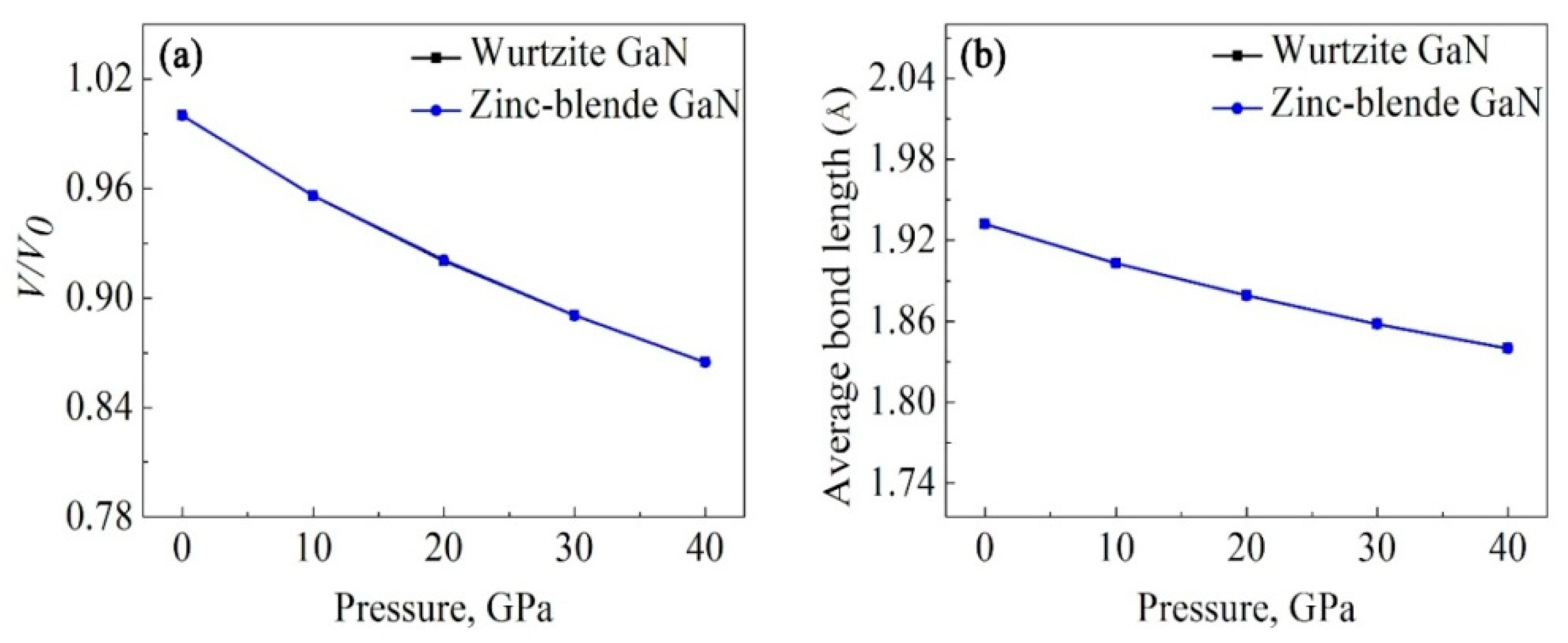
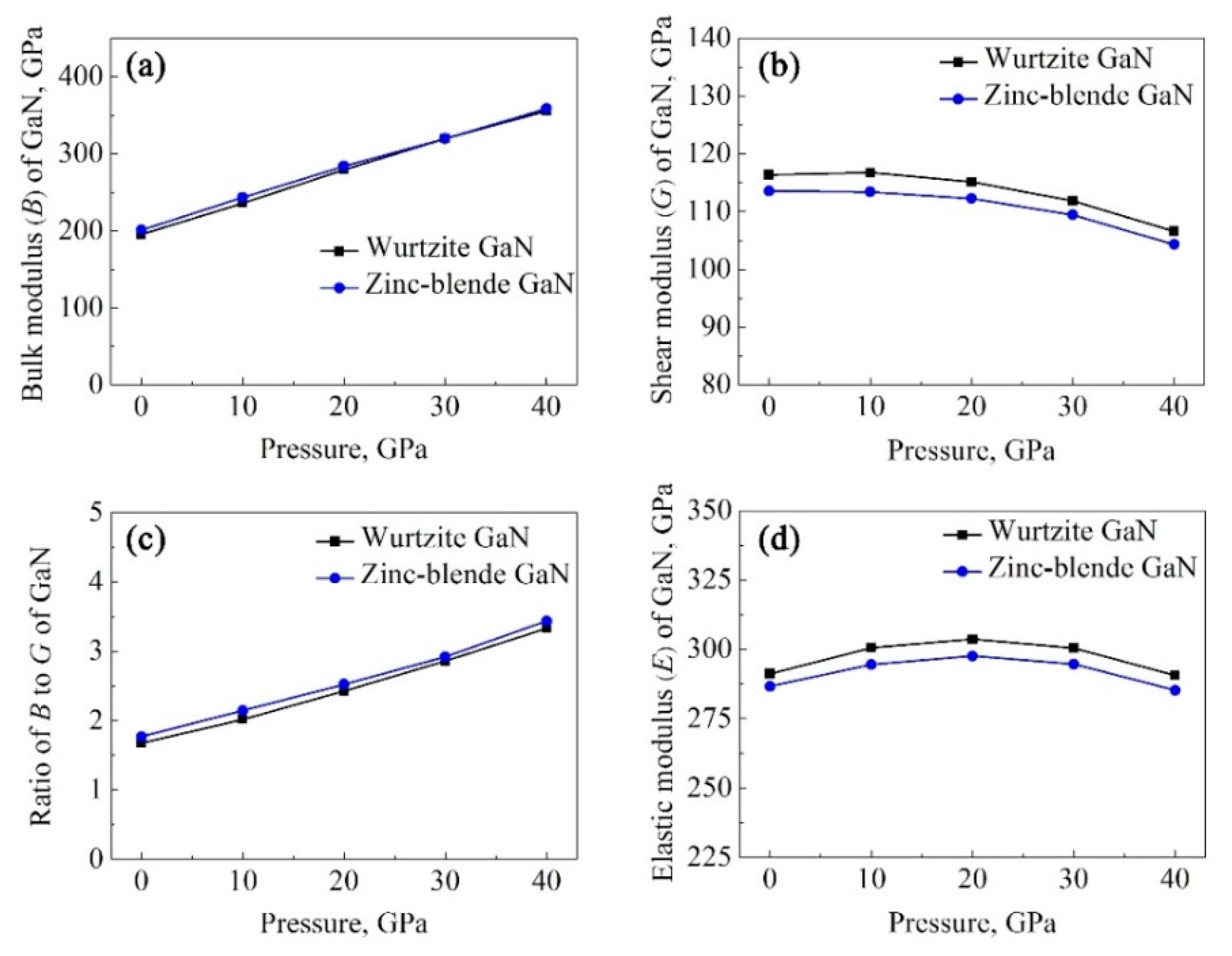
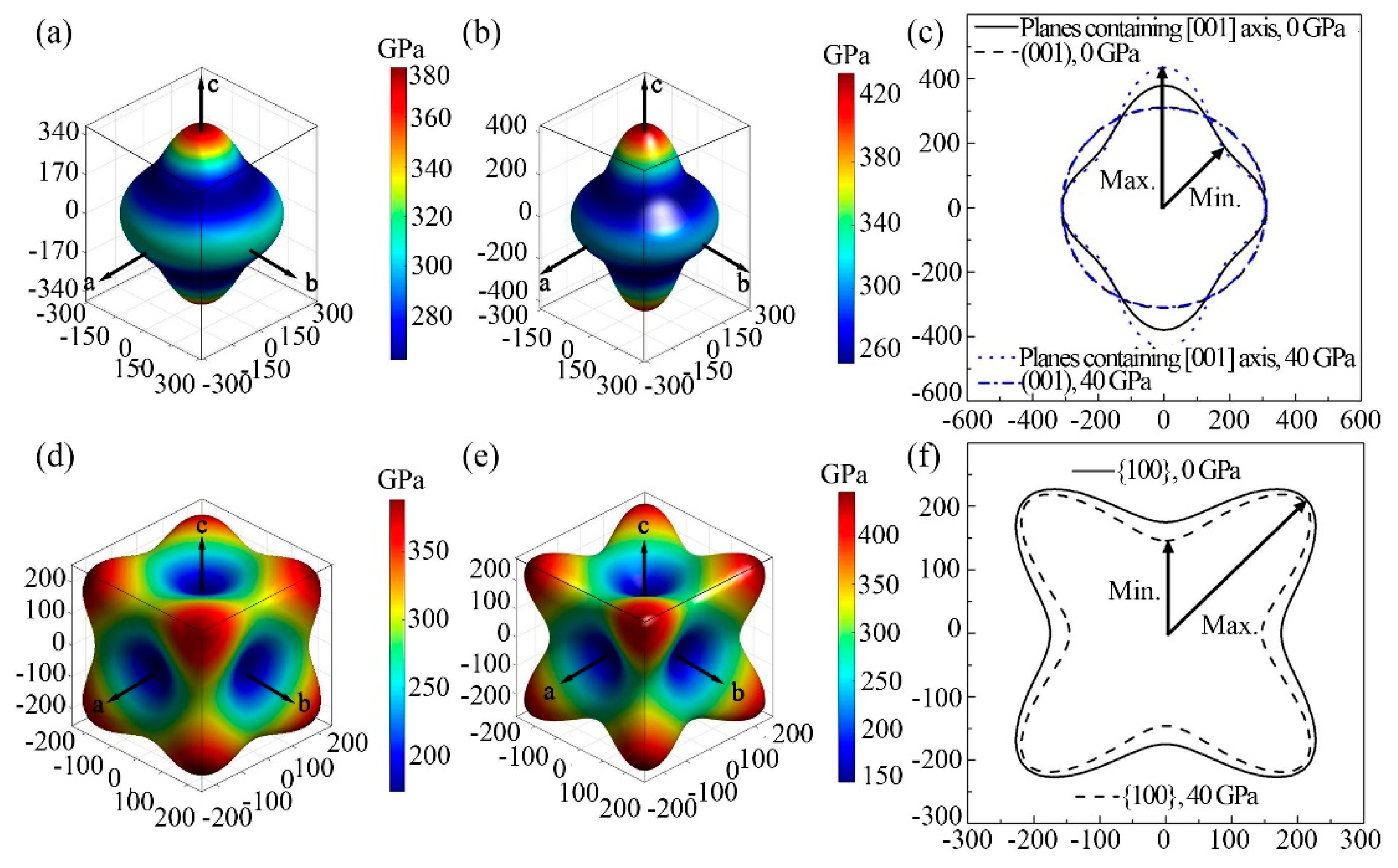
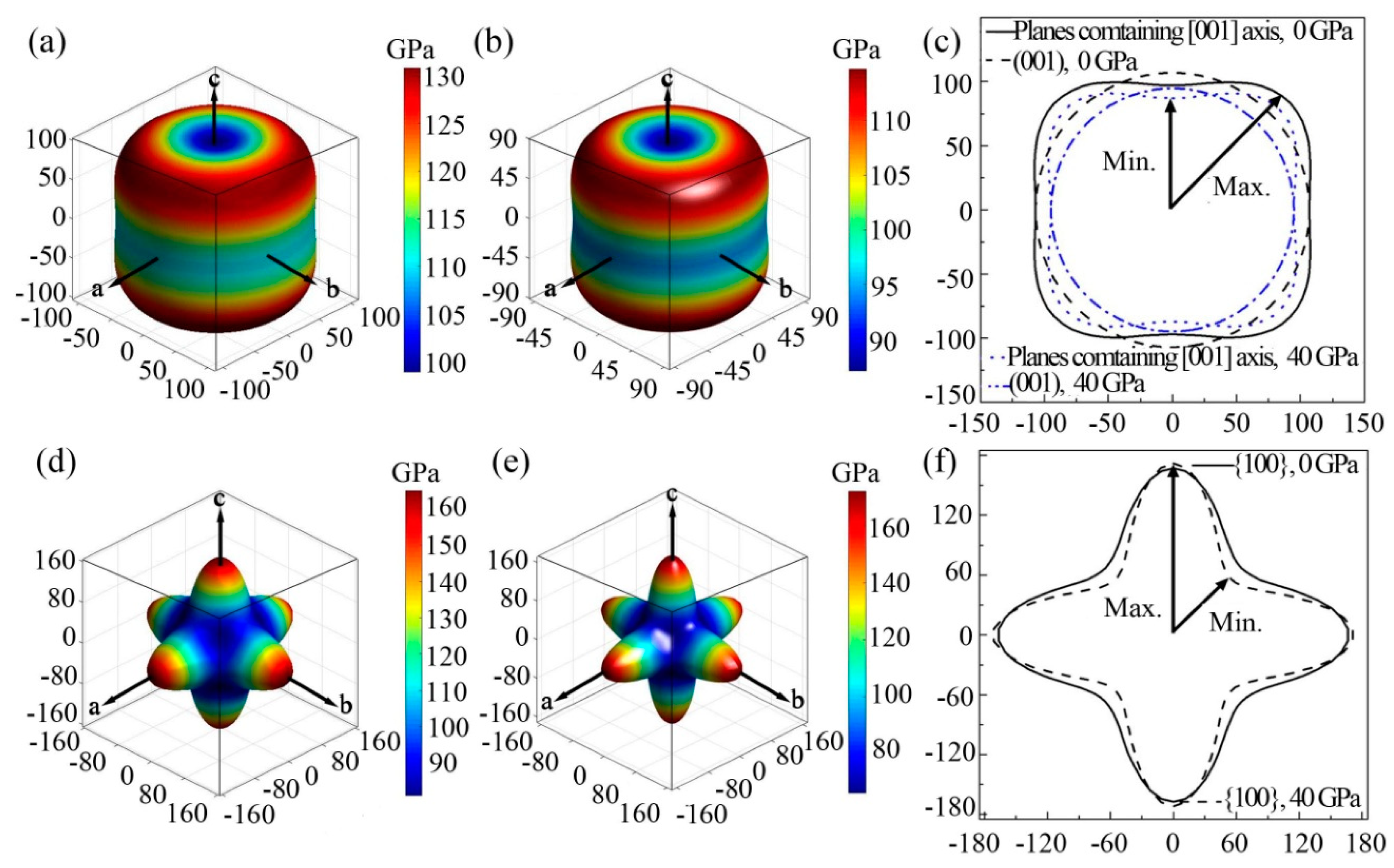

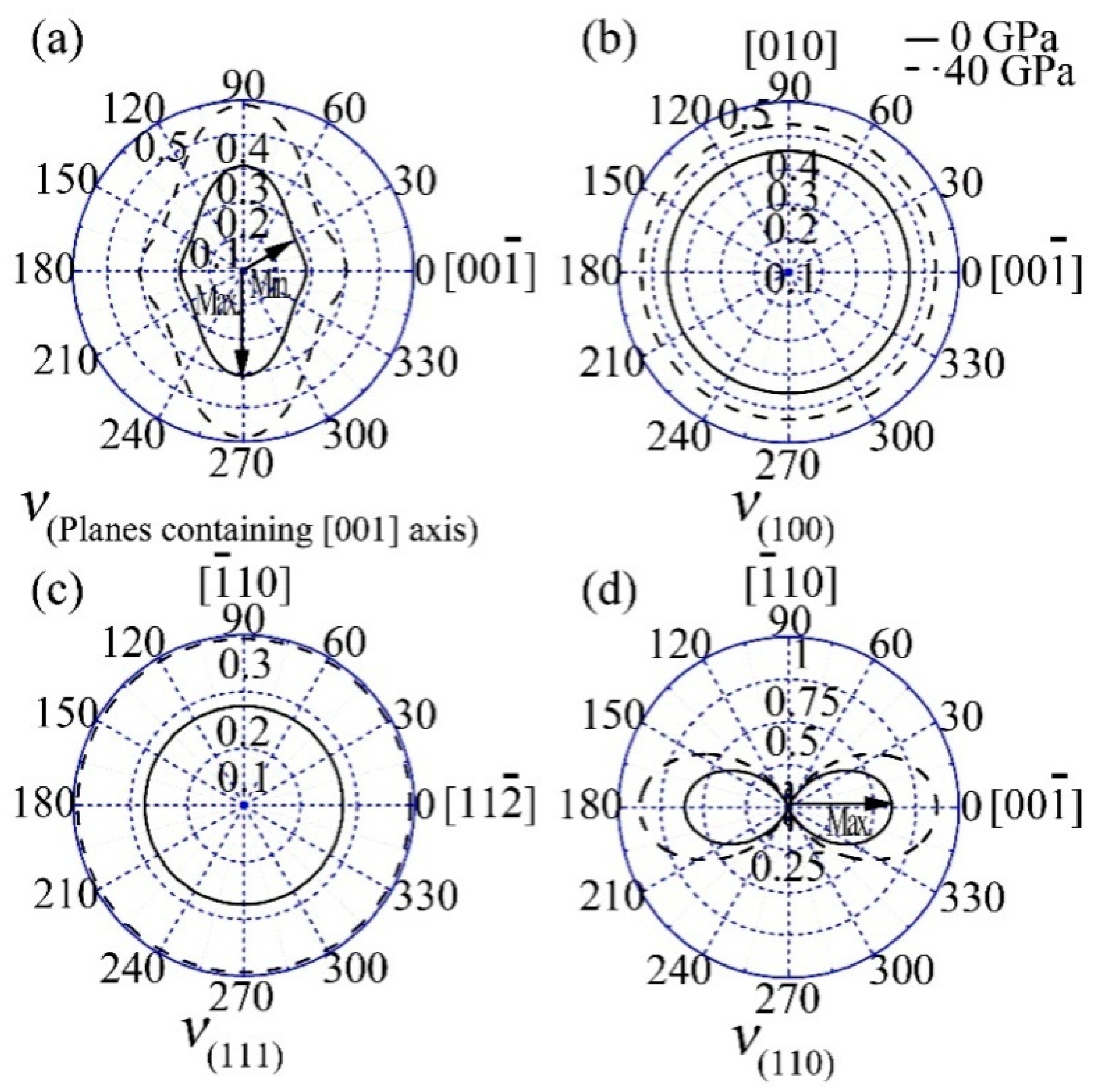
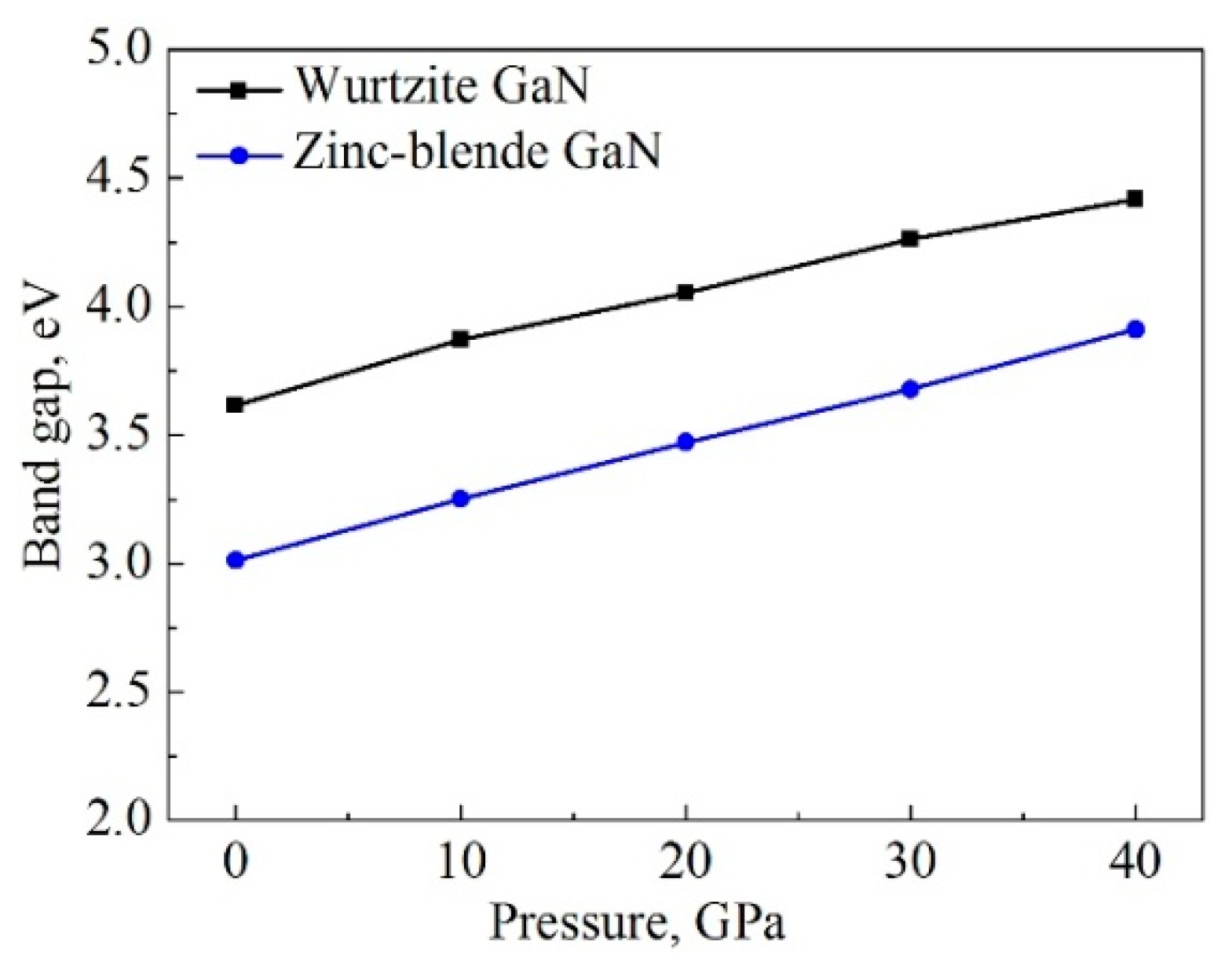
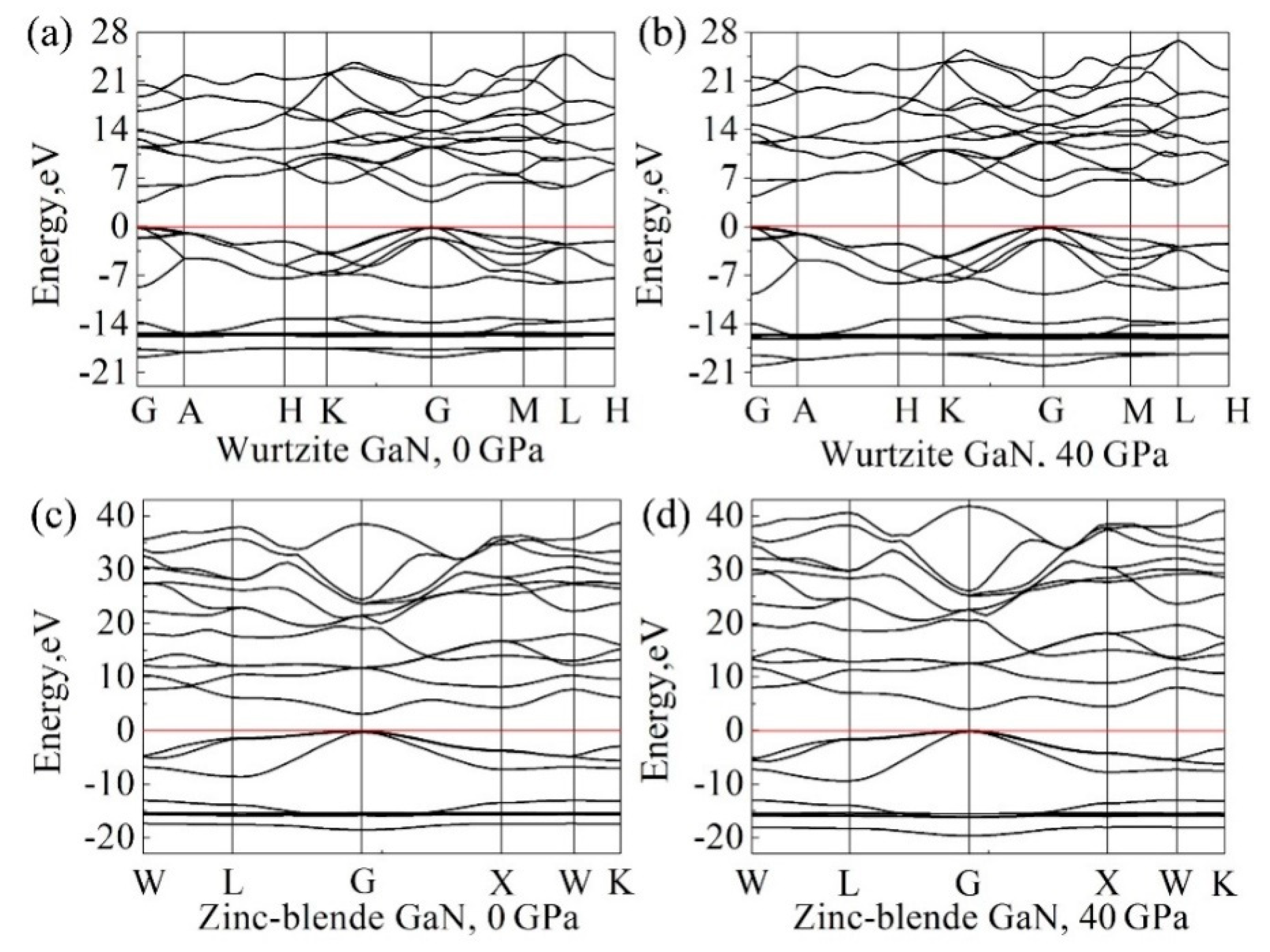
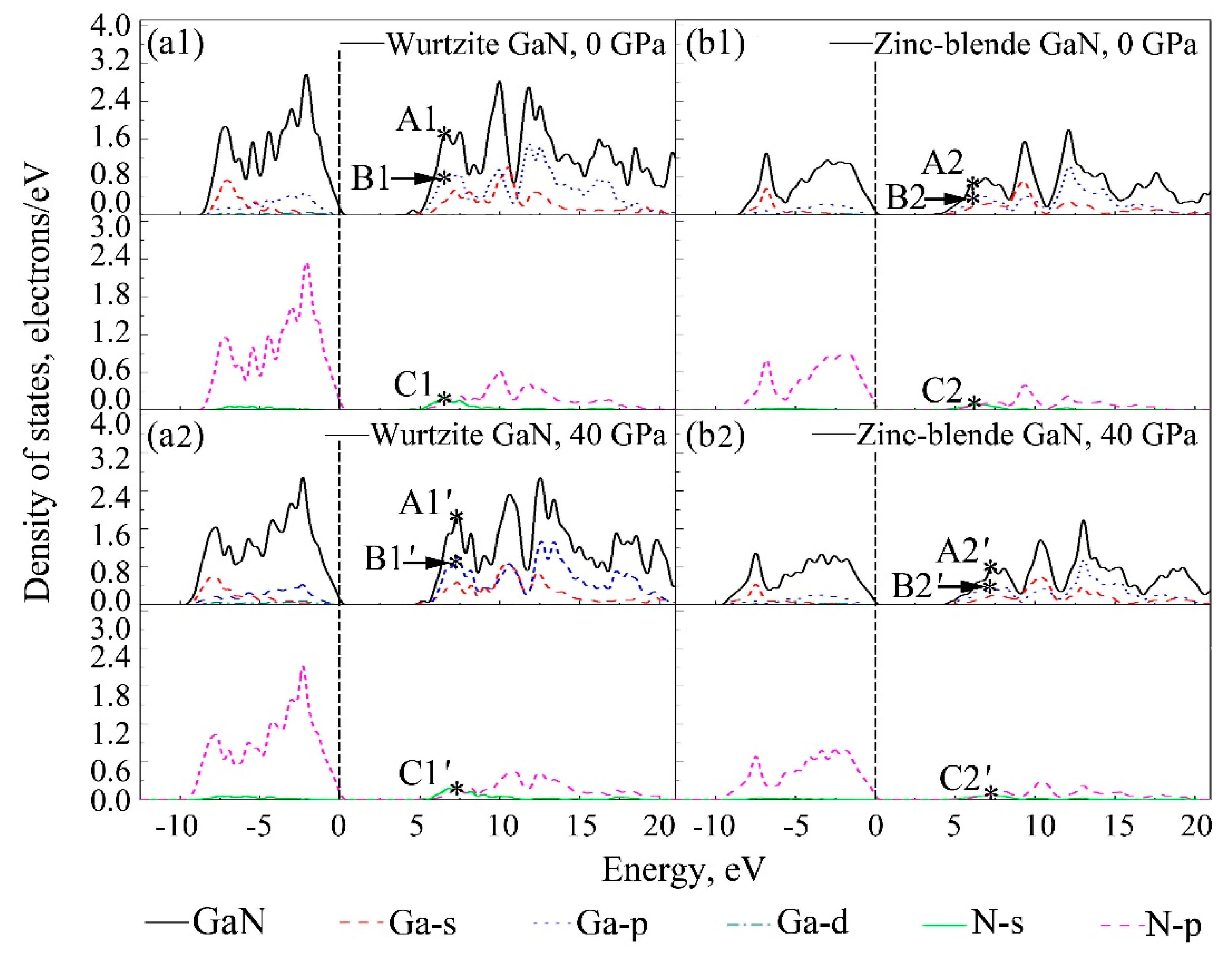
| Phase | Approach | Lattice Parameters | ||||
|---|---|---|---|---|---|---|
| a0 (Å) | b0 (Å) | c0 (Å) | c0/a0 | V0 | ||
| Wurtzite GaN (P63 mc) | GGA (present) | 3.246 | 3.246 | 5.280 | 1.627 | 48.185 |
| LDA (present) | 3.159 | 3.159 | 5.145 | 1.629 | 44.477 | |
| GGA [39] | 3.199 | 3.199 | 5.227 | 1.634 | 46.306 | |
| LDA [39] | 3.131 | 3.131 | 5.104 | 1.630 | 43.331 | |
| GGA [40] | 3.245 | 3.245 | 5.296 | 1.632 | 48.296 | |
| LDA [40] | 3.193 | 3.193 | 5.281 | 1.634 | 46.628 | |
| GGA [41] | 3.197 | 3.197 | 5.210 | 1.630 | 46.118 | |
| Expt. [42] | 3.189 | 3.189 | 5.185 | 1.626 | 45.671 | |
| Zinc-blendeGaN (F-43m) | GGA (present) | 4.582 | 4.582 | 4.582 | 1.000 | 96.217 |
| LDA (present) | 4.461 | 4.461 | 4.461 | 1.000 | 88.786 | |
| GGA [43] | 4.550 | 4.550 | 4.550 | 1.000 | 94.196 | |
| LDA [40] | 4.518 | 4.518 | 4.518 | 1.000 | 92.223 | |
| LDA [39] | 4.446 | 4.446 | 4.446 | 1.000 | 87.884 | |
| Expt. [9] | 4.490 | 4.490 | 4.490 | 1.000 | 90.519 | |
| Phases | C11 = C22 | C12 | C22 = C23 | C33 | C44 = C55 | C66 | Note |
|---|---|---|---|---|---|---|---|
| Wurtzite GaN | 364.19 | 125.99 | 364.19 | 413.68 | 97.04 | 119.10 | LDA, 0 GPa a |
| 509.98 | 302.12 | 509.98 | 585.85 | 87.06 | 103.93 | LDA, 40 GPa a | |
| 396 | 144 | 396 | 392 | 91 | 126 | LDA, 0GPa [46] | |
| 390 ± 15 | 145 ± 20 | 390 ± 15 | 398 ± 20 | 105 ± 10 | 123 ± 10 | Exp. 0 GPa [47] | |
| Zinc-blende GaN | 287.07 | 157.94 | 287.07 | 287.07 | 167.21 | 167.21 | LDA, 0 GPa a |
| 426.42 | 324.69 | 426.42 | 426.42 | 171.96 | 171.96 | LDA, 40 GPa a | |
| 285 | 161 | 285 | 285 | 149 | 149 | LDA, 0 GPa [48] | |
| 293 | 159 | 293 | 293 | 155 | 155 | LDA, 0 GPa [49] |
| Structure | B, GPa | G, GPa | E, GPa | v | B/G | Note |
|---|---|---|---|---|---|---|
| Wurtzite GaN | 195.17 | 116.35 | 291.18 | 0.25 | 1.68 | LDA, 0 GPa a |
| 355.27 | 106.58 | 290.67 | 0.36 | 3.33 | LDA, 40 GPa a | |
| 170 | 103 | 257 | 0.248 | 1.65 | GGA, 0 GPa [50] | |
| 208 | 115 | 291 | 0.267 | 1.81 | LDA, 0 GPa [50] | |
| 170 [51] 188 [52] | 116 [53] | 295 ± 3 [54] | 0.23 ± 0.06 [55] | Exp., 0 GPa | ||
| Zinc-blende GaN | 200.98 | 113.56 | 286.67 | 0.26 | 1.77 | LDA, 0 GPa a |
| 358.60 | 104.31 | 285.26 | 0.37 | 3.44 | LDA, 40 GPa a | |
| 184.41 | 105.30 | 265.38 | 0.260 | 1.75 | GGA, 0 GPa [56] | |
| 184 | 106 | 267 | 0.258 | 1.74 | GGA, 0 GPa [57] | |
| 203.7 | 110.71 | 281.18 | 0.27 | 1.84 | Exp., 0 GPa [58] |
| Structure | Symmetry | Anisotropy Factor A | |
|---|---|---|---|
| Wurtzite GaN | Planes containing the [001] axis | 0.653, 0 GPa | |
| 0.582,40 GPa | |||
| Zinc-blendeGaN | {100} | 2.560, 0 GPa | |
| 3.381,40 GPa | |||
| {110} | 1.909, 0 GPa | ||
| 2.180, 40 GPa | |||
© 2018 by the authors. Licensee MDPI, Basel, Switzerland. This article is an open access article distributed under the terms and conditions of the Creative Commons Attribution (CC BY) license (http://creativecommons.org/licenses/by/4.0/).
Share and Cite
Qin, H.; Kuang, T.; Luan, X.; Li, W.; Xiao, J.; Zhang, P.; Yang, D.; Zhang, G. Influence of Pressure on the Mechanical and Electronic Properties of Wurtzite and Zinc-Blende GaN Crystals. Crystals 2018, 8, 428. https://doi.org/10.3390/cryst8110428
Qin H, Kuang T, Luan X, Li W, Xiao J, Zhang P, Yang D, Zhang G. Influence of Pressure on the Mechanical and Electronic Properties of Wurtzite and Zinc-Blende GaN Crystals. Crystals. 2018; 8(11):428. https://doi.org/10.3390/cryst8110428
Chicago/Turabian StyleQin, Hongbo, Tianfeng Kuang, Xinghe Luan, Wangyun Li, Jing Xiao, Ping Zhang, Daoguo Yang, and Guoqi Zhang. 2018. "Influence of Pressure on the Mechanical and Electronic Properties of Wurtzite and Zinc-Blende GaN Crystals" Crystals 8, no. 11: 428. https://doi.org/10.3390/cryst8110428
APA StyleQin, H., Kuang, T., Luan, X., Li, W., Xiao, J., Zhang, P., Yang, D., & Zhang, G. (2018). Influence of Pressure on the Mechanical and Electronic Properties of Wurtzite and Zinc-Blende GaN Crystals. Crystals, 8(11), 428. https://doi.org/10.3390/cryst8110428





